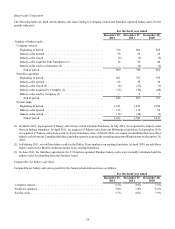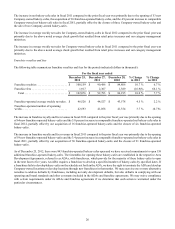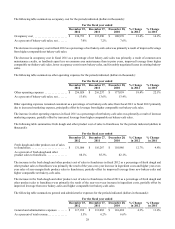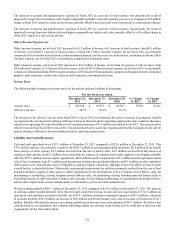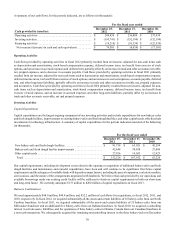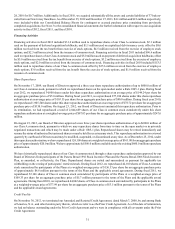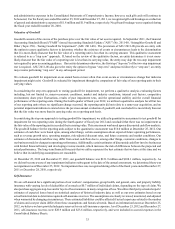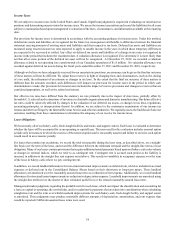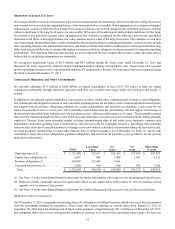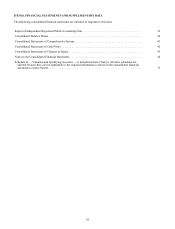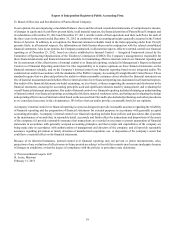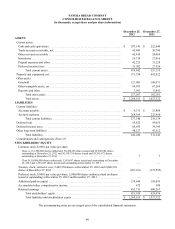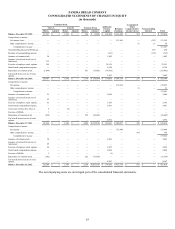Panera Bread 2012 Annual Report Download - page 41
Download and view the complete annual report
Please find page 41 of the 2012 Panera Bread annual report below. You can navigate through the pages in the report by either clicking on the pages listed below, or by using the keyword search tool below to find specific information within the annual report.33
and administrative expenses in the Consolidated Statements of Comprehensive Income; however, such gift cards will continue to
be honored. For the fiscal years ended December 25, 2012 and December 27, 2011, we recognized gift card breakage as a reduction
of general and administrative expenses of $1.8 million and $1.9 million, respectively. No gift card breakage was recognized during
the fiscal year ended December 28, 2010.
Valuation of Goodwill
Goodwill consists of the excess of the purchase price over the fair value of net assets required. In September 2011, the Financial
Accounting Standards Board ("FASB") issued Accounting Standards Update ("ASU") No. 2011-08, “Intangibles-Goodwill and
Other (Topic 350) - Testing Goodwill for Impairment” (ASU 2011-08). The provisions of ASU 2011-08 provide an entity with
the option to assess qualitative factors to determine whether the existence of events or circumstances leads to the determination
that it is more-likely-than-not that the fair value of a reporting unit is less than its carrying amount. This qualitative assessment
is referred to as a “step zero” approach. If, based on the review of the qualitative factors, an entity determines it is not more-
likely-than-not that the fair value of a reporting unit is less than its carrying value, the entity may skip the two-step impairment
test required by prior accounting guidance. If an entity determines otherwise, the first step (“step one”) of the two-step impairment
test is required. ASU 2011-08 also gives the entity the option to bypass “step zero” and proceed directly to “step one”; an entity
may resume performing “step zero” in any subsequent period.
We evaluate goodwill for impairment on an annual basis or more often if an event occurs or circumstances change that indicates
impairment might exist. Goodwill is evaluated for impairment through the comparison of fair value of our reporting units to their
carrying values.
In considering the step zero approach to testing goodwill for impairment, we perform a qualitative analysis evaluating factors
including, but not limited to, macro-economic conditions, market and industry conditions, internal cost factors, competitive
environment, share price fluctuations, results of past impairment tests, and the operational stability and the overall financial
performance of the reporting units. During the fourth quarter of fiscal year 2012, we utilized a qualitative analysis for all but two
of our reporting units where no significant change occurred, the reporting units did not relate to a same-year acquisition, and no
potential impairment indicators existed since the previous annual evaluation of goodwill, and concluded it is more likely than not
that the fair value was more than its carrying value on a reporting unit basis.
In considering the step one approach to testing goodwill for impairment, we utilized a quantitative assessment to test goodwill for
impairment for two reporting units during the fourth quarter of fiscal year 2012 and concluded that there was no impairment as
the fair value of the reporting units exceeded their carrying value. This assessment was based upon a discounted cash flow analysis.
The goodwill balance for the reporting units subject to the quantitative assessment was $16.0 million at December 25, 2012. Our
estimates of cash flow were based upon, among other things, certain assumptions about expected future operating performance,
such as revenue growth rates, operating margins, risk-adjusted discount rates, and future economic and market conditions. Our
estimates of discounted cash flow may differ from actual cash flow due to, among other things, economic conditions, changes to
our business model or changes in operating performance. Additionally, certain estimates of discounted cash flow involve businesses
with limited financial history and developing revenue models, which increases the risk of differences between the projected and
actual performance. The long-term financial forecasts that we utilize represent the best estimate that we have at this time and we
believe that its underlying assumptions are reasonable.
At December 25, 2012 and December 27, 2011, our goodwill balance was $121.9 million and $108.1 million, respectively. As
we did not become aware of any impairment indicators subsequent to the date of the annual assessment, we determined there was
no impairment as of December 25, 2012. No impairment loss was recognized during either of the fiscal years ended December 27,
2011 or December 28, 2010, respectively.
Self-Insurance
We are self-insured for a significant portion of our workers’ compensation, group health, and general, auto, and property liability
insurance with varying levels of deductibles of as much as $0.7 million of individual claims, depending on the type of claim. We
also purchase aggregate stop-loss and/or layers of loss insurance in many categories of loss. We utilize third party actuarial experts’
estimates of expected losses based on statistical analyses of historical industry data, as well as our own estimates based on our
actual historical data to determine required self-insurance reserves. The assumptions are closely reviewed, monitored, and adjusted
when warranted by changing circumstances. These estimated liabilities could be affected if actual experience related to the number
of claims and cost per claim differs from these assumptions and historical trends. Based on information known at December 25,
2012, we believe we have provided adequate reserves for our self-insurance exposure. As of December 25, 2012 and December 27,
2011, self-insurance reserves were $28.9 million and $23.6 million, respectively, and were included in accrued expenses in the
Consolidated Balance Sheets.



